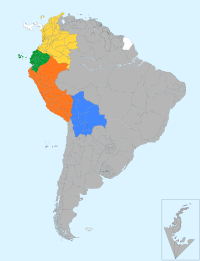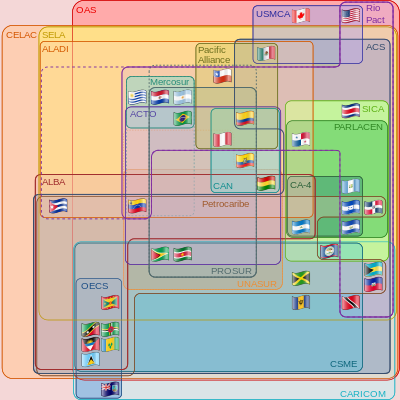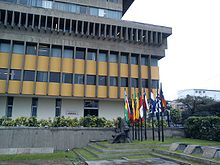| Andean CommunityComunidad Andina | |
|---|---|
 Flag
Flag | |
| Motto: "Ésta es mi tierra, ésta es mi casa" (Spanish) "This is my homeland, this is my home" | |
 | |
| Seat of Secretariat | Lima, Peru |
| Largest city | Bogota, Colombia |
| Official languages | |
| Type | Trade bloc |
| Member states |
|
| Leaders | |
| • Secretary General | Jorge Hernando Pedraza |
| Establishment | |
| • as the Andean Pact | 1969 |
| • as the CAN | 1996 |
| Area | |
| • Total | 1,470,702 sq mi (3,809,100 km) (7th) |
| Population | |
| • 2010 estimate | 101,119,783 (12th) |
| GDP (PPP) | 2017 estimate |
| • Total | $902.86 billion (9th) |
| • Per capita | $8,928.62 |
| HDI (2017) | 0.781 high |
| Website http://www.comunidadandina.org/ | |
| |
The Andean Community (Spanish: Comunidad Andina, CAN) is a free trade area with the objective of creating a customs union comprising the South American countries (Andean states) of Bolivia, Colombia, Ecuador, and Peru. The trade bloc was called the Andean Pact until 1996 and came into existence when the Cartagena Agreement was signed in 1969. Its headquarters are in Lima, Peru.
The Andean Community has 113 million inhabitants over an area of 4,700,000 km. Its GDP has gone up to US$745.300 billion in 2005, including Venezuela, which was a member at the time. Its estimated PPP of GDP for 2011 amounts to US$902.86 billion, excluding Venezuela.
Membership

The original Andean Pact was founded in 1969 by Bolivia, Chile, Colombia, Ecuador, and Peru. In 1973 the pact gained its sixth member, Venezuela. In 1976 however, its membership was again reduced to five when Chile withdrew. Venezuela announced its withdrawal in 2006, reducing the Andean Community to four member states.
Recently, with the new cooperation agreement with Mercosur, the Andean Community gained four new associate members: Argentina, Brazil, Paraguay, and Uruguay. These four Mercosur members were granted associate membership by the Andean Council of Foreign Ministers meeting in an enlarged session with the Commission (of the Andean Community) on 7 July 2005. This moves reciprocates the actions of Mercosur which granted associate membership to all the Andean Community nations by virtue of the Economic Complementarity Agreements (Free Trade agreements) signed between the CAN and individual Mercosur members.
- Current members:
- Associate members:
- Observer countries:
- Former full members:
Relationship with other organizations
| This article needs to be updated. Please help update this article to reflect recent events or newly available information. (June 2022) |

The Andean Community and Mercosur comprise the two main trading blocs of South America. In 1999, these organizations began negotiating a merger with a view to creating a "South American Free Trade Area" (SAFTA). On 8 December 2004, the Andean Community (CAN) signed a cooperation agreement with Mercosur and they published a joint letter of intention for future negotiations towards integrating all of South America in a Union of South American Nations (USAN), patterned after the European Union.
During 2005, Venezuela decided to join Mercosur. Venezuela's official position first appeared to be that, by joining Mercosur, further steps could be taken towards integrating both trade blocs. CAN Secretary General Allan Wagner stated that the Venezuelan Foreign Minister Alí Rodríguez had declared that Venezuela did not intend to leave the CAN, and its simultaneous membership to both blocs marked the beginning of their integration.
However some analysts interpreted that Venezuela might eventually leave the CAN in the process. As Colombia and Peru signed free trade agreements with the United States, in protest the Venezuelan President Hugo Chávez indeed announced in April 2006 his country's withdrawal from the CAN, stating that the Community is "dead". Officials in Colombia and Peru expressed their disagreement with this view, as did representatives from Venezuela's industrial sector (Conindustria).
In spite of this announcement, Venezuela still had not formally completed all the necessary withdrawal procedures. According to Venezuela's Commerce Minister María Cristina Iglesias, the entire process was going to take up five years. Until then, Venezuela and its partners would remain bound by the effects of the community's preexisting commercial agreements.

During a visit to Colombia in August 2007, President Hugo Chávez was asked by the presidents of Ecuador and Bolivia to rejoin the Andean Community, and he responded that he would agree. Meanwhile, at that time the Mercosur's relations with Venezuela were weakening as Mercosur was not agreeing with some of the Hugo Chávez's proposals.
Eventually Venezuela achieved the full membership of the Mercosur in 2012, making the Mercosur bigger in number of members than the CAN for the first time.
In addition to CAN, Bolivia is also a member of the WTO, UNASUR, and ALBA. Its attitude is considered crucial to relations between UNASUR and ALBA specifically, says Marion Hörmann, since Bolivia is traditionally seen as a mediator between the Andean countries and the rest of South America.
Furthermore, on 7 December 2012, the Bolivian nation was accepted by the Mercosur countries to start the incorporation protocols to achieve the Mercosur full membership in a matter of 4 years, receiving the proclamation of an accessing member, and further consolidating itself as a strategic geopolitical nation.
Chronology

- The groundwork for the Community was established in 1969 in the Cartagena Agreement
- In 1973 Venezuela joins Andean Pact
- In 1976, Augusto Pinochet withdrew Chile from the Andean Pact claiming economic incompatibilities
- In 1979, the treaty creating the Court of Justice was signed, and the Andean Parliament which in principle was located in Lima, increated and the Andean Council of Foreign Ministers were created.
- In 1981 the Andean Parliament moves to Bogotá.
- In 1983, the treaty creating the Court of Justice entered into effect
- In 1991, the presidents approved the open skies policy and agree to intensify integration
- In 1992, Peru temporarily suspended its obligations under the Liberalization Program
- In 1993, the Free Trade Zone entered into full operation for Bolivia, Colombia, Ecuador, and Venezuela
- In 1994, the Common External Tariff was approved
- In 1996, the Cartagena Agreement Commission approved the regulatory context for the establishment, operation, and exploitation of the Simón Bolívar Satellite System
- In March 1996, through the Trujillo Protocol, institutional reforms were introduced: The Andean Community was created and the Andean Integration System was established.
- In 1997, an agreement was reached for Peru's gradual incorporation into the Andean Free Trade Zone
- In 1998, the Framework Agreement for the creation of a Free Trade Area between the Andean Community and the Mercosur was signed in Buenos Aires
- In 2000, a meeting of the South American Presidents, at which the Andean Community Heads of State and Mercosur decide to launch negotiations for establishing a free trade area between the two blocs as rapidly as possible and by January 2002 at the latest
- In August 2003, the Andean Community and Mercosur Foreign Ministers, during a meeting in Montevideo at which the CAN delivered a working proposal containing guidelines for the negotiation, reaffirmed their governments' political determination to move ahead with the negotiation of a free trade agreement between the two blocs
- In April 2006 President Hugo Chávez announced that Venezuela would withdraw from the Andean Community, claiming the FTA agreements signed by Colombia and Peru with the United States caused irreparable damage to the community
- On 23 March 2017, a Memorandum of Understanding was signed between the Andean Community and the Eurasian Economic Union
- On 21 February 2020, disputed interim president of Venezuela Juan Guaidó announced Venezuela's reentry into CAN
Organization
- Andean Presidential Council
- Andean Foreign Relations Ministers Council (Lima, Peru)
- Commission (Lima, Peru)
- Headquarters (Lima, Peru)
- Andean Court of Justice (Quito, Ecuador)
- Andean Parliament (Bogotá, Colombia)
- Latin American Reserve Fund (Bogotá, Colombia and Lima, Peru)
- Simón Bolívar Andean University (Sucre, Bolivia and Quito, Ecuador)
- Andean Health Organization (Lima, Peru)
- CAF – Development Bank of Latin America and the Caribbean (Caracas, Venezuela)
Secretaries-General
Main article: Secretary-General of the Andean Community- Sebastián Alegrett (Venezuela) 1997–2002
- Guillermo Fernández de Soto (Colombia) 2002–2004
- Edward Allan Wagner Tizón (Peru) 2004–2006
- Alfredo Fuentes Hernández (Colombia), interim 2006–2007
- Freddy Ehlers (Ecuador), 2007–2010
- Adalid Contreras Baspineiro (Bolivia), interim 2010–2011, 2011–2013
- Pablo Guzmán Laugier (Bolivia), 2013–2016
- Walker San Miguel (Bolivia), 2016–present
Free flow of people
Since 1 January 2005, the citizens of the member countries can enter the other Andean Community member states without the requirement of a visa. Travellers should present the authorities their national ID cards.
Visitors to Venezuela will have to present their passports; they will then receive the Andean Migration Card (Tarjeta Andina de Migración), in which the time of temporary residence in the country is stated.
Andean passport
Main article: Andean passportThe Andean passport was created in June 2001 pursuant to Decisión 504. This stipulates the issuing of a passport based on a standard model which contains harmonised features of nomenclature and security. The passport is effective in Ecuador, Peru, Venezuela and Bolivia (Bolivia since early 2006).
See also
- Central American Common Market
- Community of Latin American and Caribbean States
- Customs Union
- Free Trade Area of the Americas
- Mercosur
- Trade bloc
- Union of South American Nations
- Rules of Origin
- Market access
- Free-trade area
- Tariffs
References
- "Ecuador". International Monetary Fund. Archived from the original on 4 May 2011. Retrieved 21 April 2011.
- "Bolivia". International Monetary Fund. Archived from the original on 4 May 2011. Retrieved 21 April 2011.
- "Colombia". International Monetary Fund. Archived from the original on 14 May 2011. Retrieved 21 April 2011.
- "Peru". International Monetary Fund. Retrieved 6 May 2011.
- "CAN – Mercosur". Archived from the original on 16 June 2002.
- ^ "SOMOS COMUNIDAD ANDINA". Andean Community of Nations. Archived from the original on 24 July 2013. Retrieved 12 July 2014.
- In the framework of the Union of South American Nations and/or Mercosur-CAN cooperation agreements
- "Le Maroc obtient le statut de membre observateur au sein de la Communauté andine des Nations". MAP Express (in French). Retrieved 9 July 2020.
- "Türkiye welcomes observer status in Andean Community". Anadolu Agency. Retrieved 15 September 2022.
- "Announcement by the Ministry of Foreign Affairs regarding the acceptance of Greece's request for observer status in the Andean Community of Nations (CAN) (17.06.2023)". Ministry of Foreign Affairs (Greece).
- "Andean Community-MERCOSUR". SICE Foreign Trade Information System. The General Secretariat of the Organization of American States. Archived from the original on 8 December 2023. Retrieved 6 May 2024.
- "Secretario general de la CAN: Es positivo el ingreso de Venezuela al Mercosur" (in Spanish). The General Secretariat of the Organization of American States. Archived from the original on 11 March 2008. Retrieved 8 December 2005.
- Prada, Paulo (8 December 2005). "South American Trade Bloc Moves to Admit Venezuela". The New York Times. Archived from the original on 19 January 2013. Retrieved 24 December 2008.
- "Venezuela to Withdraw From Andean Free Trade Group". Latin America. Bloomberg.com. 19 April 2006. Retrieved 24 December 2008.
- "Conindustria: "Inevitable" y negativa salida de Venezuela de la CAN" (in Spanish). Eluniversal.com. 20 April 2006. Retrieved 24 December 2008.
- "Secretario general de la CAN espera que convoquen cita sobre Venezuela" (in Spanish). Eluniversal.com. 22 April 2006. Retrieved 24 December 2008.
- "Vocero de las Farc se reunirá en Venezuela con Hugo Chávez para hablar sobre acuerdo humanitario". Eltiempo.com. 31 August 2007. Retrieved 24 December 2008.
- Marion Hörmann, "Key Role for Bolivia Archived 2011-09-27 at the Wayback Machine" D+C Development and Cooperation, German Federal Ministry for Economic Cooperation and Development, 2010/03, 103–105.
- "Bolivia signs Mercosur incorporation protocol and becomes sixth member".
- "The EEC and the Andean Community General Secretariat signed a Memorandum of Understanding". eurasiancommission.org.
- "Guaidó anunció el reingreso de Venezuela a la Comunidad Andina de Naciones (Comunicado)". La Patilla (in European Spanish). 21 February 2020. Retrieved 23 February 2020.
- Andean Community of Nations, 18 Jan 2007, Ecuadorian Freddy Ehlers is elected CAN Secretary General Archived 2013-07-29 at the Wayback Machine
- Andean Community of Nations, 20 Apr 2010, (in Spanish) Freddy Ehlers renuncia a la Secretaría General de la CAN Archived 25 April 2010 at the Wayback Machine
- (in Spanish) Andean Community of Nations, 19 Feb 2013, Boliviano Adalid Contreras concluye su gestión como Secretario General de la CAN con un llamado a fortalecer la integración Archived 18 February 2015 at the Wayback Machine
- (in Spanish) Andean Community of Nations, 15 Jun 2013,"Boliviano Pablo Guzmán es elegido como Secretario General de la CAN|ARCHIVO FOTOGRAFICO | Prensa | Portal de la Comunidad Andina". Archived from the original on 18 February 2015. Retrieved 31 July 2014.
- (in Spanish) Andean Community of Nations, 11 Jan 2016,"Walker San Miguel es elegido como Secretario General de la Comunidad Andina|NOTAS DE PRENSA | Prensa | Portal de la Comunidad Andina". Archived from the original on 22 March 2016. Retrieved 20 January 2016.
- Schacknies, Carly (17 May 2021). "Andean Community Approves Reciprocal Movement and Residence Rights". Erickson Immigration Group. Retrieved 17 August 2024.
External links
- Official Andean Community website—(in Spanish)
- BBC.uk: "South America launches trading bloc" —(in English)
| Andean Community of Nations | |
|---|---|
| Members | |
| Associate members | |
| Observers | |
| Union of South American Nations | |||||
|---|---|---|---|---|---|
| Members |
| ||||
| Summits | |||||
| Topics | |||||
| Related | |||||
12°2′S 77°1′W / 12.033°S 77.017°W / -12.033; -77.017
Categories:- Andean Community
- Andes
- Customs unions
- Free trade agreements
- Trade blocs
- Development in South America
- South American integration
- Economic policy in South America
- Economy of South America
- International organizations based in the Americas
- Intergovernmental organizations established by treaty
- Territorial entities in South America
- Union of South American Nations
- United Nations General Assembly observers
- Economy of Bolivia
- Economy of Colombia
- Economy of Ecuador
- Economy of Peru
- Foreign relations of Bolivia
- Foreign relations of Colombia
- Free trade agreements of Colombia
- Foreign relations of Ecuador
- Foreign relations of Peru
- 1969 in economic history
- Organizations established in 1969
- Organizations established in 1996
- 1969 establishments in South America
- 1996 establishments in South America